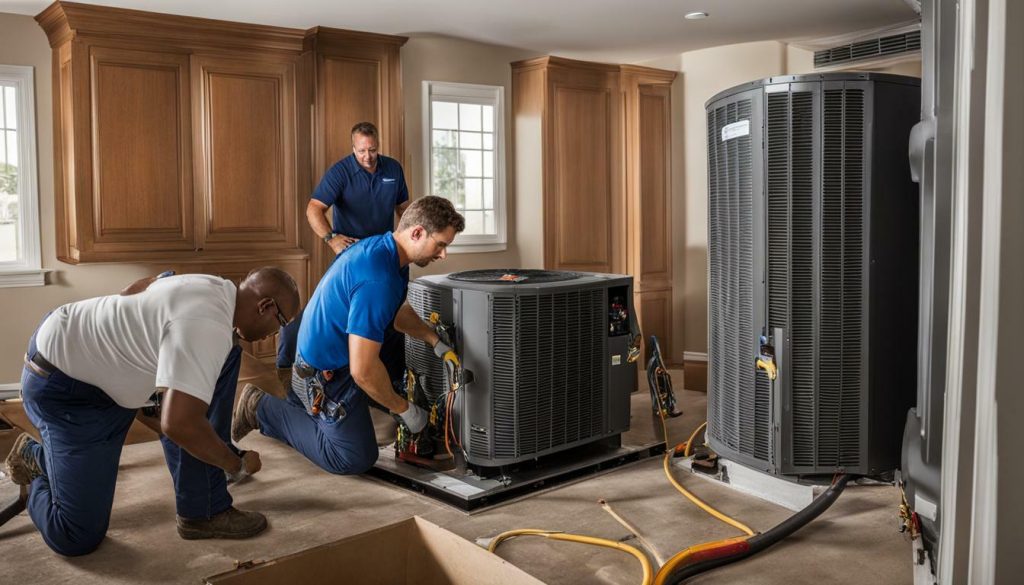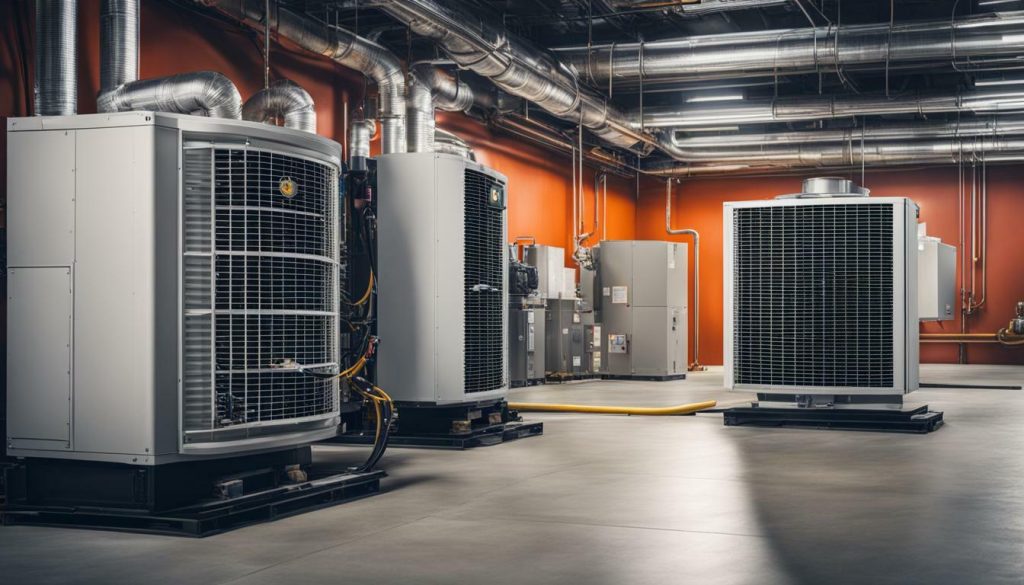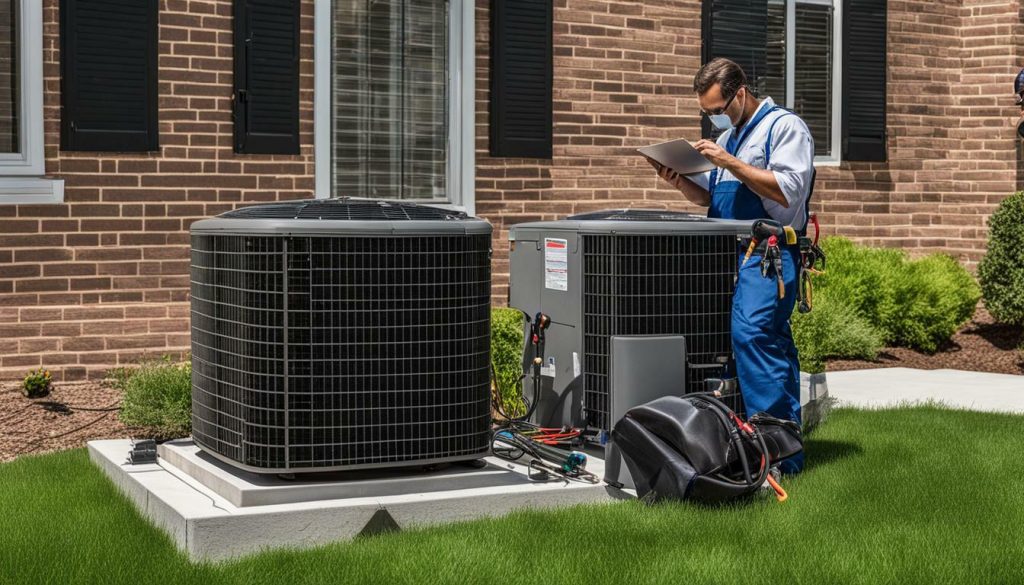Pricing HVAC change orders correctly is crucial for maximizing profitability in the HVAC industry. By understanding the various costs involved and effectively tracking and documenting them, you can ensure proper compensation for your work. In this article, we will explore the different types of costs associated with HVAC change orders and provide insights into pricing strategies that can help you maximize your profitability.
Key Takeaways:
- There are three types of costs to consider when pricing HVAC change orders: direct costs, overhead and indirect costs, and consequential costs.
- Direct costs include labor, materials, equipment, and expenses related to analyzing, estimating, and communicating changes.
- Overhead and indirect costs cover expenses like rent, utilities, and administrative staff salaries.
- Consequential costs involve disruptions to workflow, such as work delays, overtime, crew reassignment, and site access issues.
- Accurately tracking and documenting all three types of costs is crucial for ensuring proper compensation.
Factors to Consider in Pricing HVAC Change Orders
When pricing HVAC change orders, it is important to consider the specific factors involved, whether it is an installation, service work, or an upgrade. Each type of work presents its own challenges and considerations that can impact pricing decisions. By carefully analyzing these factors, HVAC contractors can ensure accurate and profitable pricing for change order work.
Factors for HVAC Installations
For HVAC installations, factors such as equipment size, complexity, and location play a crucial role in pricing change orders. Larger equipment and complicated installations may require additional time and resources, which should be reflected in the pricing. Additionally, the location of the installation can affect labor and material costs, as accessibility and logistics may vary.
Factors for HVAC Service Work
When pricing HVAC service change orders, factors like the nature of the repair or maintenance work, the urgency of the request, and the availability of parts need to be considered. Emergency repairs or time-sensitive service work may require expedited or overtime labor, impacting the overall cost. Moreover, the availability and cost of specific parts or components can influence pricing decisions.
Factors for HVAC Upgrades
For HVAC upgrades, factors such as system compatibility, energy efficiency requirements, and customer preferences play a significant role in pricing change orders. Upgrading existing systems to meet new standards or customer demands may involve additional labor, materials, or equipment, all of which should be factored into the pricing equation.
By carefully considering these factors for each type of HVAC change order, contractors can ensure accurate pricing that covers all relevant costs and maximizes profitability. It is essential to evaluate the specific requirements and complexities of each project to provide fair and competitive pricing for HVAC change orders.
| Factors to Consider | HVAC Installations | HVAC Service Work | HVAC Upgrades |
|---|---|---|---|
| Equipment Size | ✓ | ||
| Complexity | ✓ | ||
| Location | ✓ | ||
| Nature of Work | ✓ | ||
| Urgency | ✓ | ||
| Availability of Parts | ✓ | ||
| System Compatibility | ✓ | ||
| Energy Efficiency | ✓ | ||
| Customer Preferences | ✓ |

By taking into account these factors, HVAC contractors can ensure that their pricing decisions for change orders are accurate and reflect the unique requirements of each project. It is crucial to carefully evaluate the specific factors involved in HVAC installations, service work, and upgrades to provide competitive pricing that considers all necessary expenses and maximizes profitability.
Direct Costs of HVAC Change Orders
Direct costs play a significant role in pricing HVAC change orders, encompassing labor, materials, and equipment, along with other related expenses. When considering labor costs, it is crucial to accurately track the time spent on the change order work, including any overtime or additional personnel required. Materials costs should include the cost of any new components or parts needed for the changes, as well as any disposal or recycling fees for the old materials.
Equipment costs are another factor to consider, including the rental or purchase costs of specialized tools or machinery required for the change order work. It is essential to document these costs accurately to ensure proper compensation for the additional resources utilized.
To effectively track and document these direct costs, it can be helpful to use a comprehensive system or software that allows for easy recording and categorization. This will enable you to generate accurate cost reports and invoices, ensuring transparency and facilitating proper communication with clients.
In addition to labor, materials, and equipment, it is also crucial to account for other related expenses, such as analyzing the changes, estimating the costs, and communicating the changes to the client and other stakeholders. These indirect costs should be carefully documented and included in the pricing of the change order to ensure profitability and avoid any potential disputes.

Example Table: Direct Costs Breakdown
| Cost Category | Details |
|---|---|
| Labor | Hours worked, overtime, additional personnel |
| Materials | New components, disposal/recycling fees |
| Equipment | Rental/purchase costs for specialized tools/machinery |
| Analysis & Estimation | Time spent on evaluating changes and estimating costs |
| Communication | Costs related to informing clients and stakeholders about the changes |
Overhead and Indirect Costs of HVAC Change Orders
In addition to direct costs, it is essential to factor in overhead and indirect costs when pricing HVAC change orders to achieve maximum profitability. These costs may not be as immediately apparent as labor and materials, but they play a significant role in determining the overall profitability of a project. By accurately accounting for these costs, you can ensure that your pricing is both fair and sustainable.
Overhead costs encompass various expenses that are necessary for your business to function but are not directly tied to a specific project. These can include rent, utilities, insurance, and administrative staff salaries. It’s important to allocate a portion of these costs to each change order to accurately reflect the true cost of the work being performed.
Indirect costs, on the other hand, are related to the specific HVAC change order project but are not directly tied to labor or materials. These might include project management salaries, equipment maintenance, and other expenses that contribute to the successful completion of the project. By accounting for these costs, you can ensure that you’re adequately compensated for the resources and expertise you provide.

| Overhead Costs | Indirect Costs |
|---|---|
| Rent | Project management salaries |
| Utilities | Equipment maintenance |
| Insurance | |
| Administrative staff salaries |
By carefully considering both overhead and indirect costs, you can ensure that your pricing for HVAC change orders is fair, transparent, and profitable. Allocating a portion of these costs to each project will give you a more accurate understanding of the total expenses involved. This, in turn, will allow you to set pricing that reflects the true cost of the work you’re providing, ultimately leading to greater profitability and success.
Consequential Costs of HVAC Change Orders
Consequential costs can significantly impact the profitability of HVAC change orders, and it is essential to understand and address them in the pricing process. These costs are the result of disruptions to workflow and project timelines, which can lead to increased expenses and potential setbacks. By properly identifying and considering these consequential costs, HVAC contractors can ensure accurate pricing that reflects the true impact of change orders.
Some common examples of consequential costs include work delays, which can result in additional labor costs and extended project timelines. Overtime may be necessary to catch up on lost time, leading to increased expenses. Crew reassignment might be required if resources need to be reallocated to address the changes, which can further impact productivity. Site access issues can also cause delays, preventing work from proceeding as planned.
It is crucial to document and account for these consequential costs effectively. By keeping detailed records and justifying the impact these disruptions have on the project, contractors can ensure that they are properly compensated. This includes accurately tracking additional labor hours, material costs, and any other expenses incurred due to the change orders. By doing so, contractors can better protect their profitability and maintain successful project outcomes.

Consequential Costs of HVAC Change Orders
| Consequential Costs | Impact |
|---|---|
| Work Delays | Increased labor costs and extended project timelines |
| Overtime | Additional expenses to catch up on lost time |
| Crew Reassignment | Productivity impact due to the reallocation of resources |
| Site Access Issues | Delays in project progress due to restricted or limited access |
By recognizing the consequences of change orders and properly accounting for the associated costs, HVAC contractors can navigate the pricing process with greater accuracy. Understanding and addressing these consequential costs is key to maintaining profitability and delivering successful projects.
Tracking and Documenting Costs for Proper Compensation
Accurate tracking and documentation of costs are vital to ensure proper compensation for HVAC change order work and to establish transparency in the pricing process. To effectively track costs, it is essential to maintain detailed records of labor, materials, and equipment expenses. This includes recording the hours spent on each task, the quantity and price of materials used, and any equipment rentals or purchases made specifically for the change order. By diligently tracking these direct costs, you can accurately calculate the true cost of the change order and avoid undercharging or overcharging.
In addition to direct costs, overhead and indirect costs must also be accounted for. These expenses, such as rent, utilities, and administrative staff salaries, are not directly tied to a specific change order but are necessary for the overall operation of your HVAC business. By properly allocating these costs to each change order, you ensure that your pricing is fair and reflects the true cost of the work.
Tracking and Documenting Costs Table
| Cost Category | Examples |
|---|---|
| Direct Costs | Labor, materials, equipment, analysis, estimation, communication |
| Overhead and Indirect Costs | Rent, utilities, administrative staff salaries |
| Consequential Costs | Work delays, overtime, crew reassignment, site access issues |
Lastly, it is crucial to properly document and justify the costs of your change orders. Clear and transparent communication with the client is essential. Provide detailed explanations for cost items, outlining the specific labor, materials, and equipment involved. By justifying your costs, you increase the client’s confidence in your pricing and avoid misunderstandings or disputes.
By following these practices, you can ensure that your pricing for HVAC change orders is accurate, transparent, and fair. Accurate tracking and documentation of costs, along with proper classification and justification, will help you secure proper compensation for your work and maintain profitability. Remember, the success of your HVAC projects relies on a well-structured and thoroughly documented approach to change orders.
![]()
Understanding Change Order Approval Procedures
Understanding the change order approval procedures is essential for successfully pricing HVAC change orders and ensuring profitability. When a change order is requested, it is crucial to thoroughly review the contract’s terms and conditions to determine the proper approval process. Identifying and following the established procedures will help avoid delays and disputes, allowing for a smoother project execution.
During the approval process, it is important to communicate effectively with all relevant stakeholders, including clients, project managers, and subcontractors. Clearly explaining the scope of the change, the associated costs, and the potential impact on the project timeline will help facilitate informed decision-making and ensure everyone is on the same page.
In some cases, it may be necessary to negotiate higher limits for change orders to protect profitability. This can involve discussing the potential risks and challenges associated with the requested changes and presenting a compelling argument for the adjustment. By advocating for reasonable limits, contractors can safeguard their financial interests while still accommodating necessary modifications to the project.
Illustrative Example: Change Order Approval Process
| Step | Description |
|---|---|
| 1 | Review contract terms and conditions |
| 2 | Determine approval process |
| 3 | Communicate change details and costs |
| 4 | Obtain necessary approvals |
| 5 | Document approved changes |
By following these change order approval procedures, HVAC contractors can maintain control over project costs, protect profitability, and ensure successful project completion.

The Benefits and Costs of Providing Free Change Work
While offering some free change work in the HVAC industry can have benefits, it is crucial to carefully consider the costs involved and ensure they are properly accounted for. Providing free change work can help build goodwill with clients and enhance customer satisfaction. It shows a willingness to go above and beyond to meet their needs, which can lead to repeat business and positive referrals. Additionally, by offering free change work, HVAC contractors can avoid potential conflicts and maintain positive relationships with clients.
However, it is important to remember that providing free change work comes with costs that need to be properly documented and credited. These costs include labor, materials, and equipment, as well as the time spent analyzing, estimating, and communicating changes. It’s essential to accurately track and document these costs to ensure that they are appropriately compensated.
Properly classifying and justifying costs in change orders is crucial for project success and profitability. By accurately accounting for all expenses related to change work, contractors can ensure that their pricing remains competitive and profitable. Clear and transparent communication with clients, along with detailed explanations for cost items, helps establish trust and minimize any potential disputes.
Table: Cost Considerations for Free Change Work
| Cost Considerations | Description |
|---|---|
| Labor | The time spent by the HVAC team to complete the change work, including any additional hours or overtime. |
| Materials | The cost of any additional materials or equipment required for the change work. |
| Equipment | The use of specialized tools or machinery during the change work. |
| Analysis and Estimation | The time and effort spent in assessing the impact of the change, estimating costs, and planning accordingly. |
| Communication | The cost of effectively communicating with the client regarding the change, including meetings, phone calls, and documentation. |
Providing free change work can be a strategic decision for HVAC contractors, but it is essential to carefully evaluate the costs and benefits. By accurately tracking and documenting costs, properly justifying expenses, and maintaining transparent communication, contractors can ensure project success and maintain profitability.

Disclaimer: The image above is for illustrative purposes only and does not represent the specific context discussed in this section.
Justifying Costs in Change Orders for Project Success
Properly justifying costs in HVAC change orders is crucial for project success, client satisfaction, and maintaining profitability. When presenting change orders to clients, it is essential to provide a transparent breakdown of the costs involved. This can be achieved by preparing a detailed table that clearly outlines the labor, materials, equipment, and any other direct costs associated with the change order.
By presenting the information in a structured and comprehensive manner, you demonstrate professionalism and build trust with your clients. Additionally, including supporting documentation such as receipts, invoices, and vendor quotes reinforces the validity of your cost justifications. This level of transparency helps clients understand the necessity and value of the change order, increasing their satisfaction with your services.
Moreover, proper cost justification is essential for maintaining profitability. By thoroughly analyzing and documenting the direct, overhead, and indirect costs incurred, you can accurately calculate the impact of the change order on your bottom line. This information allows you to make informed decisions regarding pricing adjustments and ensure that the change order will contribute positively to your project’s financial success.
| Cost Category | Details |
|---|---|
| Direct Costs | Labor, materials, equipment, analyzing and estimating costs |
| Overhead and Indirect Costs | Rent, utilities, administrative staff salaries, and other expenses |
| Consequential Costs | Work delays, overtime, crew reassignment, site access issues, and other workflow disruptions |
By clearly categorizing and justifying these costs, you can demonstrate the value of your work and effectively communicate the impact of the change order on the project’s timeline and budget. This level of transparency and accuracy not only enhances client trust but also helps you maintain a healthy profit margin.

In conclusion, justifying costs in HVAC change orders is a critical aspect of project management. By providing transparent and detailed cost breakdowns, supported by appropriate documentation, you can strengthen client relationships, ensure profitability, and contribute to project success.
Conclusion
Pricing HVAC change orders effectively is fundamental for maximizing profitability in the HVAC industry, and taking into account the various costs and considerations discussed can significantly contribute to achieving this goal.
To ensure proper compensation for change order work, it is crucial to accurately track and document the three types of costs involved. Direct costs, including labor, materials, equipment, and expenses related to analyzing and estimating changes, should be thoroughly recorded. Overhead and indirect costs, such as rent, utilities, and administrative staff salaries, must also be accounted for. Additionally, consequential costs, which encompass disruptions to workflow like work delays, overtime, crew reassignment, and site access issues, should not be overlooked.
Understanding the change order approval procedures outlined in the contract and negotiating higher limits can further protect profitability. By thoroughly reviewing contract terms and conditions, identifying and following established approval processes, and advocating for higher limits, HVAC professionals can ensure smooth and effective change order management.
While providing some free change work can have its benefits, such as building goodwill and avoiding conflicts, it is essential to document and credit the costs incurred. Striking the right balance between providing free change work and maintaining profitability is key.
Properly classifying and justifying costs in change orders is crucial for project success. Clear and transparent communication with clients, along with detailed explanations for cost items, can help build trust and confidence. Accurate project documentation plays a critical role in justifying costs and ensuring that both parties are satisfied with the final outcome.
In conclusion, pricing HVAC change orders effectively requires careful consideration of direct costs, overhead and indirect costs, and consequential costs. By accurately tracking and documenting these costs, understanding change order approval procedures, and justifying expenses, HVAC professionals can maximize profitability and achieve success in their projects.
FAQ
What are the three types of costs to consider when pricing HVAC change orders?
The three types of costs to consider are direct costs, overhead and indirect costs, and consequential costs.
What do direct costs include?
Direct costs include labor, materials, equipment, and expenses related to analyzing, estimating, and communicating changes.
What do overhead and indirect costs cover?
Overhead and indirect costs cover expenses such as rent, utilities, and administrative staff salaries.
What do consequential costs involve?
Consequential costs involve disruptions to workflow, including work delays, overtime, crew reassignment, and site access issues.
Why is it important to track and document all three types of costs?
Accurately tracking and documenting all three types of costs ensures proper compensation for change order work.
How can understanding change order approval procedures and negotiating higher limits protect profitability?
Understanding the contract’s change order approval procedures and negotiating higher limits can help protect profitability by ensuring fair compensation for additional work.
What are the benefits and costs of providing free change work in the HVAC industry?
Providing free change work can have benefits like building goodwill and avoiding conflicts. However, the costs should be documented and credited to maintain profitability.
Why is justifying costs in change orders crucial for project success?
Properly justifying costs in change orders is crucial for project success as it ensures transparency, clear communication with clients, and proper compensation for additional work.





0 Comments